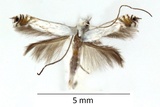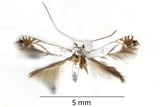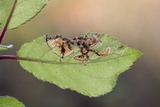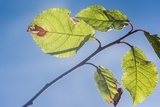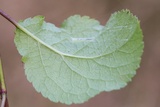Lyonetia prunifoliella (Hübner, 1796) Species
Last modified: Dec. 9, 2025, 4:56 p.m.
The first confirmed Belgian record was on 01 June 1997 at Lessive (NA).
It is a rare and local species throughout Belgium.
Details
- Classification
- Family: Lyonetiidae > Subfamily: Lyonetiinae > Genus: Lyonetia > Species: Lyonetia prunifoliella
- Vernacular names
- Sleedoornhangmatmot (NL), Striped Bent-wing (EN), Schlehen-Langhornminierfalter (DE)
- First mention in Belgium
- De Prins W. 2003. Four new species for the Belgian fauna (Lepidoptera: Lyonetiidae, Coleophoridae, Pterophoridae). — Phegea 31(3): 87–90. On page 87 (as Lyonetia prunifoliella (Hübner, 1796)). view page
- Status
-
Native
Distribution
Caterpillar
The caterpillar is pale green.
Mine
The mine starts as a narrow gallery that is almost completely filled with red-brown frass. Later on, this gallery ends abruptly in a blotch in which the grainy black frass is distributed.
See also bladmineerders.be
Bionomics
The eggs are deposited on the underside of a leaf.
The young larva initially mines a narrow gallery that is almost completely filled with red-brown frass. Later on, this gallery suddenly ends into a blotch in which the grainy black frass is distributed and is often located against the leaf margin. Nevertheless, part of the frass is worked out by the caterpillar that makes, for this purpose, one or more holes in the lower epidermis. A part of that expelled frass remains hanging in the silken fibers spun by the caterpillar at the bottom of the leaf.
The caterpillar only mines at the underside in young leaves of the food plant and can leave its mine and start another one, sometimes even on a different leaf.
Pupation takes place in a peculiar silken hammock, constructed by the caterpillar.
Flight periods
The adults are on the wing from May till the beginning of July and then again from August to September.
Observed on
- Host plant (species):
- Prunus spinosa and Malus sylvestris
- Host plant (genera):
- Cotoneaster, Crataegus, Sorbus, Cydonia, Mespilus, Chaenomeles and Betula
The larva lives mainly on Prunus spinosa but also other Rosaceae such as Crataegus, Malus, Cotoneaster, Sorbus, Cydonia, Chaenomeles and Mespilus are accepted as hostplant.
Only occasionally it had been found also on Betula.
